
Home | Gallery
Guide | The Provincetown AIDS Art Archives Contact Us | How You Can Help
Contact Us | How You Can Help
A | B | C | D | E | F | G | H | I | J | K | L | M | N | O | P | Q | R | S | T | U | V | W | Y | Z
UVM community touched by AIDS plague
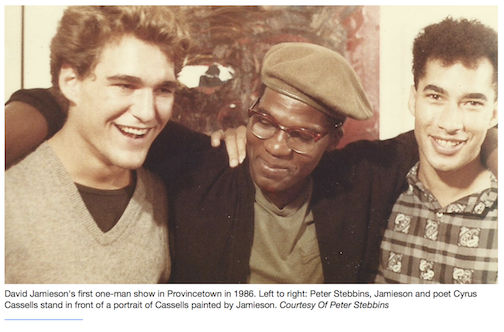
Artist David Bethuel Jamieson left Burlington in a hurry. It was the fall of 1991 and in less than a year he would be dead.
Too weakened by AIDS to pack up his studio at 61 S. Willard St., Jamieson asked a friend living nearby for help. He was headed to his birthplace of Washington, D.C. to be alone. He wanted to spend his remaining days making art in solitude.
Colton Rienecke, who was a few years behind Jamieson at the University of Vermont, helped him hurriedly pack up his belongings. Jamieson didn't bother taking everything. Many items were left scattered across the floor, including several drawings and a notebook.
Before Rienecke went home, Jamieson gathered the drawings and notebook and gave them to him.
"It was a quick gesture of thank you," Rienecke said over the phone. "He could have just left them. I really don't think they were that important to him because he was dying. He probably cared more about his bigger pieces."
While the work may not have been important to Jamieson, the notebook contained sketches from UVM's second Waterman takeover.
The takeover occurred in spring 1991 when 22 students occupied the president's office in the Waterman Building. The students demanded greater awareness and promotion of diversity. Other student supporters set up a group of tents outside that they named Diversity University, which was supposed to be a learning site for alternative education.
Jamieson was among those students who occupied the tents. He sketched fellow protesters in the notebook he gave Rienecke.
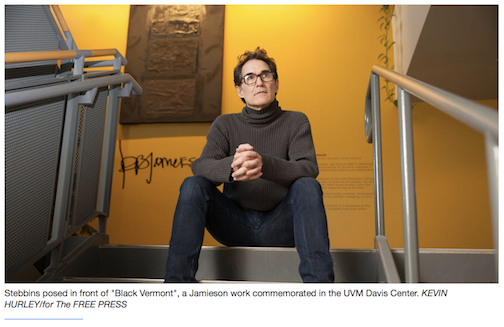
"The importance of the Waterman notebook is really kind of cool," Rienecke said. Jamieson took care to date his sketches, many of which were done after midnight.
Janie Cohen, director of UVM's Fleming Museum of Art, is familiar with Jamieson's work and has exhibited pieces of his at the museum.
"He really served as the artist-reporter for the movement in the late '80s and early '90s," Cohen said of Jamieson.
Nearly a quarter century later, images Jamieson made during those years are on display at University of Vermont.
Jamieson's partner Peter Stebbins championed the exhibit at UVM's Living/Learning Center, where he and Jamieson met in 1983 during their freshman year of college.
"Resurrections: Art by David Bethuel Jamieson (1963-1992)" includes facsimiles, a slideshow, a large painting of a woman with a very long neck and a crate of records that Jamieson played in his studio. Visitors are invited to put on a record of their choice while viewing the exhibit, which will be on display through Thursday.
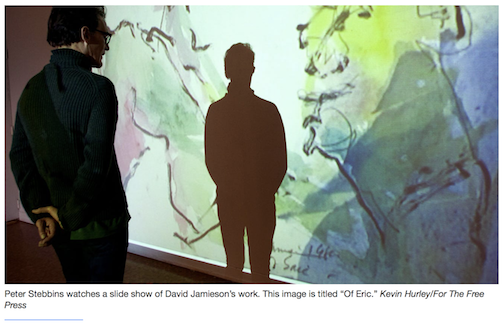
Discoveries
Those who knew Jamieson are still finding things out about his life and work.
Stebbins only learned recently of the sketches given to Rienecke, when a mutual friend put them in touch. The existence of these sketches was somewhat of a surprise because Stebbins has been collecting and cataloging Jamieson's work since his death in 1992.
"I wondered about it all spring," Stebbins said.
Eventually, Stebbins went to see the drawings. He immediately recognized they are related to the work that he had been keeping. They told the story of what was going on at the University of Vermont as well as Jamieson's personal history.
"There's a beginning, a middle and an end, and the work speaks to it," Stebbins said recently of Jamieson's art. "They really form a lexicon of what he was most interested in."
Jamieson's life was marked by hardship. He was taken from his parents as a baby and spent his childhood in several different foster homes. He was kicked out of high school and completed his GED before gaining entrance to the University of Vermont.
Bill Davison, a retired art professor, worked with Jamieson while he studied at UVM.
"He was a very brave and forceful young student," Davison said. "He was working with material that was probably provocative at the time. He was an adopted child. He was a black child, and he was gay."
Jamieson also had a tendency to disregard rules, which put him at odds with Davison.
"David and I had contentious times," Davison said.
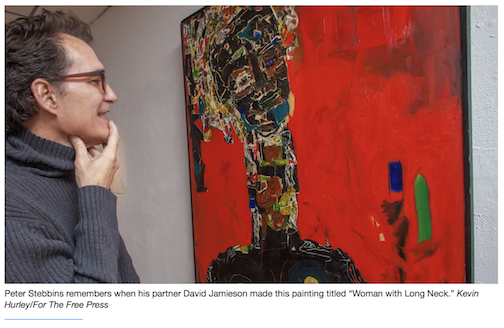
Jamieson refused to pay a $20 lab fee, re-purposed some of the projects done in Davison's class to get credit in other classes and shirked responsibility for a piece of damaged equipment. While other professors shied away from confronting Jamieson, Davison refused to back down.
"On one occasion there was a very loud and somewhat public exchange of profanities between David and myself," Davison said. "He felt I was picking on him." The confrontation took place in on the bottom floor of Williams Hall, the ornate 19th century building that houses the university's art department.
"It was huge," Davison said of the argument. "It was heard upstairs."
The two eventually made peace. Jamieson handed over the $20 lab fee, and Davison invited Jamieson to exhibit his work at UVM's Colburn Art Gallery. This was Jamieson's final exhibit before his death.
"It resolved our differences," Davison said. "It was two positions coming together."
When Davison attended the "Resurrections" reception on Oct. 30, he discovered something else they had in common: jazz.
"I was the first person there," Davison said. "There was some music on, and I was astonished. I was a huge fan of Keith Jarrett. I thought, 'Oh my God, Dave was listening to Keith Jarrett.'"
For Mary Jane Dickerson, seeing the exhibit brought up raw emotion. The retired English professor taught Jamieson and also hosted him for holiday celebrations. She, too, attended the reception.
"David, his impact as far as I am concerned was very very significant," Dickerson said on Tuesday. "He was very complex as a person. He loved art. Loved jazz. He did that as much and as long as he could."
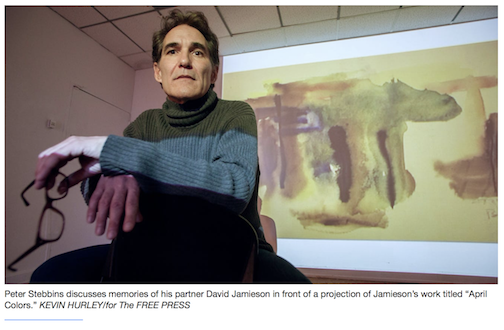
A message
The exhibit of Jamieson's work asks viewers to do more than just listen and look.
A plaque by the entrance states, "Please use the guestbook to share your comments about the show, as well as your personal relationship with HIV/AIDS — whether as witness, caregiver, survivor, or person living today in the aftermath of the onslaught."
Stebbins, who curated the exhibit, hopes that Jamieson's work will spark dialogue and awareness. He has experienced the disease not only as a caregiver but also as a carrier. Since 1988, Stebbins has known that he has HIV. Fortunately, he is among the less than 5 percent of infected individuals whose disease has not progressed.
Jamieson learned of his HIV status in 1990, Stebbins said.
"I'm not going to deal with this. I'm just going to make art," Stebbins recalled Jamieson saying at the time.
Despite Jamieson's determination to not let his health get in the way, it was unavoidable. As Jamieson became increasingly ill he began to push Stebbins away and made the decision move to Washington D.C., where he could be alone with his art.
"His final body of work was mainly on paper, which I think was related to the immediacy," Stebbins said. A number of those pieces can be seen at the current exhibit.
When Jamieson's became too ill to care for himself, Stebbins went to D.C to care for him. During that time, Stebbins promised that he would organize a full retrospective exhibit of Jamieson's work. He has yet to do that, but the current UVM exhibit offers a glimpse of what that retrospective might look like.
At the exhibit's reception, Stebbins set out to give a speech about the work but "went off script."
"I talked about what it was like to forge a relationship in an environment where that was not standard," Stebbins said. "To live through the AIDS plague, to be affected by it, personally and as a student."
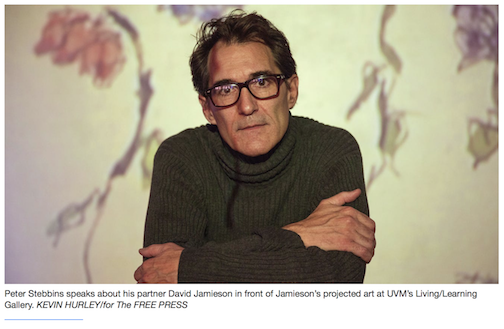
Stebbins had a relationship with Jamieson for eight years and 11 months. Although Stebbins served as a caregiver for Jamieson toward the end, their connection was always about art.
"Our relationship was fused not only emotionally but in regards to his career development," Stebbins said.
After Jamieson learned that he was ill, the two traveled together around the eastern U.S. and Canada. They sold Jamieson's work to keep their trip going.
When asked if it is now difficult to see Jamieson's work, Stebbins said no.
"For me it's an incredible joy to see the work and know it's safe," he said
Joan Watson, co-director of the Living/Learning Gallery, said that she encouraged Stebbins to bring the exhibit to UVM because of her personal relationship with the couple as well as the impact their story could have on students.
Watson knew Stebbins and Jamieson while they were residents of the Living/Learning Center. She also saw Jamieson when he was quite sick and leaving Burlington for the last time. The show, she said, has awakened some of her grief over Jamieson's death.
"There's not a lot we can do about that," she added.
What she can do is influence the way her current students think about art and AIDS before she moves into retirement. Watson plans to finish her career in May.
"Our students think about AIDS and HIV as you just have to wear a condom," Watson said. "They don't think of the huge artistic loss."
She hopes the exhibit will also inspire students.
"David's work is important because it does have so much energy to it," Watson said. "It's important to share with students because he developed his work at such a young age."
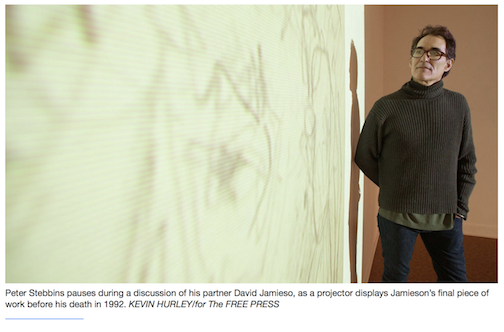
..................................................
Established in 2001 © Provincetown Artist Registry | P.O. Box 675, North Truro, MA 02652 | 508 487-0011